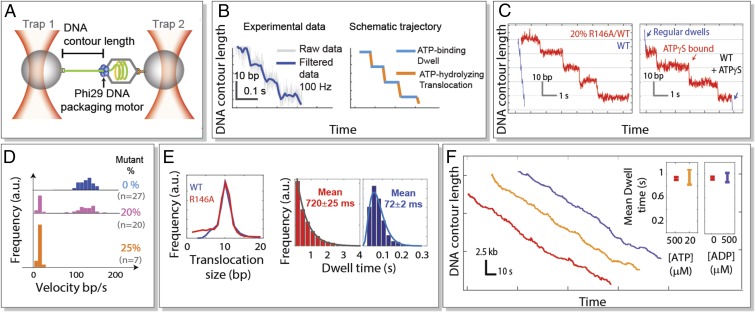Fig. 1.
Packaging behavior of R146A/WT hybrid motors. (A) Single-molecule DNA packaging experiments. A viral packaging particle is held between two optical traps. (B, Left) Experimental DNA packaging trajectory acquired at 2,500 kHz (gray) and down-sampled to 100 Hz (blue). (B, Right) Schematic packaging biphasic cycle. ATP-binding “dwell” phase: DNA remains stationary (light blue). ATP-hydrolyzing “burst” phase: DNA is translocated into the protein capsid (orange). (C, Left) High-resolution packaging trajectories of WT (blue) and slow R146A/WT hybrid motors from a mixture containing 20% mutant subunits (red). (C, Right) Sample packaging trajectory of WT motors in the presence of the nonhydrolyzable nucleotide ATPγS in a 1:500 ([ATP]:[ATPγS]) ratio. ATPγS-induced pauses are highlighted in red; regular packaging behavior is in blue. (D) Velocity distribution of R146A/WT hybrid motors for different mixing ratios. (E) Analysis of the translocation size (Left) and dwell times (Right) of slow R146A/WT hybrid rings (red) fitted to a single-exponential distribution (gray) vs. WT motors (blue) fitted to a gamma distribution. (F) Sample packaging trajectories of R146A/WT hybrid motors and mean dwell times under different packaging conditions: saturating [ATP] (red; [ATP] = 500 μM), low [ATP] (yellow; [ATP] = 20 μM), and in competition with ADP (purple; [ATP] = [ADP] = 500 μM).

